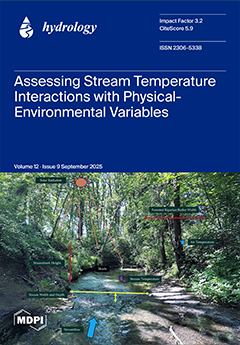Submerged vanes offer a promising solution for reducing scour depth around hydraulic structures such as bridge piers by modifying near-bed flow patterns. However, temporal changes in bed profiles around a cylindrical pier remain insufficiently quantified. This study employs three machine learning models (MLMs),
[...] Read more.
Submerged vanes offer a promising solution for reducing scour depth around hydraulic structures such as bridge piers by modifying near-bed flow patterns. However, temporal changes in bed profiles around a cylindrical pier remain insufficiently quantified. This study employs three machine learning models (MLMs), gene expression programming (GEP), support vector regression (SVR), and an artificial neural network (ANN), to simulate the temporal evolution of the bed profile around a cylindrical pier under constant subcritical flow. We use a published laboratory flume dataset (106 observations) obtained for a pier of diameter
and uniform sediment with median size
. Geometric/layout parameters of the submerged vanes (number
n, transverse offset
z, longitudinal spacing
e, and distance from the pier base
a) were fixed at their reported optima, and subsequent tests varied installation angles
to minimize scour. Models were trained on
of the data and tested on
using dimensionless inputs
with
t the elapsed time from the start of the run and
the equilibrium time at which scour growth becomes negligible and response
with
s the instantaneous scour depth at time
t. The GEP model with a three-gene structure achieved the best accuracy. During training and testing, GEP attained
and
, respectively, where
denotes scour depth at equilibrium state,
D is the pier diameter, and
is the maximum dimensionless depth ratio observed/predicted.
Full article





